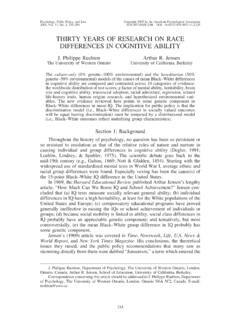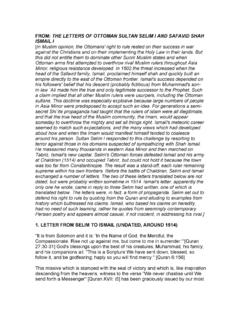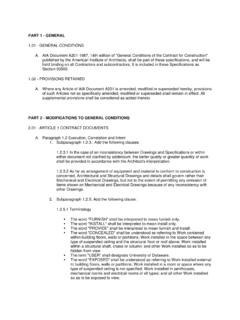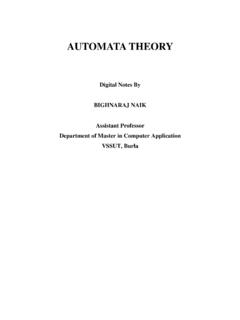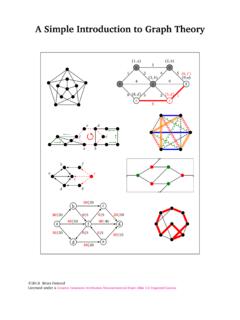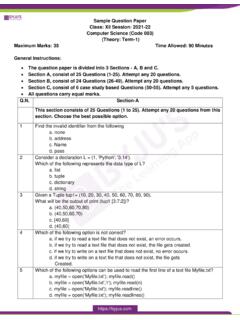Transcription of Chapter 6 Quantum Theory and the Electronic Structure of …
1 Copyright McGraw-Hill 20091 Chapter 6 Quantum Theory and the Electronic Structure of Atoms Copyright McGraw-Hill The Nature of Light The electromagnetic spectrum includes many different types of radiation. Visible light accounts for only a small part of the spectrum Other familiar forms include: radio waves, microwaves, X rays All forms of light travel in waves Copyright McGraw-Hill 20093 Electromagnetic Spectrum Figure McGraw-Hill 20094 Wave Characteristics Wavelength: (lambda) distance between identical points on successive or troughs Frequency: (nu) number of waves that pass a particular point in one second Amplitude.
2 The vertical distance from the midline of waves to the top of the peak or the bottom of the trough Copyright McGraw-Hill 20095 Copyright McGraw-Hill 20096 Wave Characteristics Wave properties are mathematically related as: c= wherec = x 108m/s (speed of light) = wavelength (in meters, m) = frequency (reciprocal seconds, s 1)Copyright McGraw-Hill 20097 Wave Calculation The wavelength of a laser pointer is reported to be 663 nm. What is the frequency of thislight? Copyright McGraw-Hill 20098 Wave Calculation The wavelength of a laser pointer is reported to be 663 nm.
3 What is the frequency of thislight? 66379 c Copyright McGraw-Hill 20099 Your Turn! Calculate the wavelength of light, in nm,of light with a frequency of x 1014 s-1. Copyright McGraw-Hill 200910 Calculate the wavelength of light, in nm,of light with a frequency of x 1014 s-1. c nm Copyright McGraw-Hill Quantum Theory 1900 -Max Planck Radiant energy could only be emitted or absorbed in discrete quantities Quantum : packets of energy Correlated data from blackbody experiment to his Quantum Theory Revolutionized way of thinking (energy is quantized) Copyright McGraw-Hill 200912 Quantum Theory Energy of a single Quantum of energywhereE= energy (in Joules) h= Planck s constant x 10 34 J s = frequency hE Copyright McGraw-Hill 200913 Photoelectric Effect Electrons ejected from a metal s surface when exposed to light of certain frequency Einstein proposed that particles of light are really photons(packets of light energy)
4 And deduced thatEphoton= h Copyright McGraw-Hill 200914 Only light with a frequency of photons such that h equals the energy that binds the electrons in the metal is sufficiently energetic to eject electrons. If light of higher frequency is used, electrons will be ejected and will leave the metal with additional kinetic energy. (what is the relationship between energy and frequency?) Light of at least the threshold frequency andof greater intensitywill eject moreelectrons. Copyright McGraw-Hill 200915 Calculate the energy (in joules) of a photon with a wavelength of nmCopyright McGraw-Hill 200916 Calculate the energy (in joules) of a photon with a wavelength of )s10s)( ( Copyright McGraw-Hill 200917 Your Turn!
5 Calculate the wavelength (in nm) of lightwith energy x 10 19J per photon. Inwhat region of the electromagneticradiation does this light fall? Copyright McGraw-Hill 200918 Calculate the wavelength (in nm) of lightwith energy x 10 19J per photon. Inwhat region of the electromagneticradiation does this light fall? Ultraviolet regionnm 253or Copyright McGraw-Hill 200919 Photoelectric Effect Dilemma caused by this Theory -is light a wave or particle? Conclusion: Light must have particle characteristics as well as wave characteristics Copyright McGraw-Hill Bohr s Theory of the Hydrogen Atom Planck s Theory along with Einstein s ideas not only explained the photoelectric effect, but also made it possible for scientists to unravel the idea of atomic line spectraCopyright McGraw-Hill 200921 Atomic Line Spectra Line spectra.
6 Emission of light only at specific wavelengths Every element has a unique emission spectrum Often referred to as fingerprints of the element Copyright McGraw-Hill 200922 Atomic Line SpectraCopyright McGraw-Hill 200923 Bright-line Spectra Copyright McGraw-Hill 200924 Line Spectra of Hydrogen The Rydberg equation: Balmer (initially) and Rydberg (later) developed the equation to calculate all spectral lines in hydrogen 2221111nnR Copyright McGraw-Hill 200925 Line Spectra of Hydrogen Bohr s contribution: showed only valid energies for hydrogen s electron with the following equation 2181 McGraw-Hill 200926 Line Spectra of Hydrogen As the electron gets closer to the nucleus, Enbecomes larger in absolute value but also more negative.
7 Ground state: the lowest energy state of an atom Excited state: each energy state in which n> 1 Copyright McGraw-Hill 200927 Line Spectrum of Hydrogen Each spectral line corresponds to a specific transition Electrons moving from ground state to higher states require energy; an electron falling from a higher to a lower state releases energy Bohr s equation can be used to calculate the energy of these transitions within the H atom Copyright McGraw-Hill 200928 Energy Transitions Calculate the energy needed for an electron to move from n= 1 to n= McGraw-Hill 200929 Energy Transitions Calculate the energy needed for an electron to move from n= 1 to n=.
8 Final initial levels 22181141 ECopyright McGraw-Hill 200930 Copyright McGraw-Hill Wave Properties of Matter Bohr could not explain why electrons were restricted to fixed distances around the nucleus Louis de Broglie (1924) reasoned that if energy (light) can behave as a particle (photon) then perhaps particles (electrons) could exhibit wave characteristics Copyright McGraw-Hill 200932 Wave Properties of Matter De Broglie proposed that electrons in atoms behave as standing waves (like the wave created when a guitar string is plucked) There are some points called nodes (where the wave exhibits no motion at all) Copyright McGraw-Hill 200933 Wave Properties of Matter Copyright McGraw-Hill 200934 Wave Properties of Matter De Broglie s idea of particle and wave properties are related by the followingwhere = wavelengthm= mass (kg)u= velocity (m/s)muh Copyright McGraw-Hill 200935 Calculate the de Broglie wavelength ofthe particle in the following two cases: A g bullet traveling at 612 m/sAn electron (mass = x 10 31kg) moving at m/sNote.
9 1 Joule = 1 kg m2/s2 Copyright McGraw-Hill 2009A g bullet traveling at 612 m/sAn electron (mass = x 10 31 kg)moving at m/s * Wavelengths of macroscopic particles are imperceptibly small and really have no physical significance.*m ) kg)(612 ( m ) kg)( ( /sm 36 Copyright McGraw-Hill Quantum Mechanics Scientists yearned to understand exactly where electrons are in an atom. Heisenberg s uncertainty principle mathematically described the position and velocity of an electron. The more you know about one, the less you are sure about the other quantity.
10 Copyright McGraw-Hill 200938 Quantum Mechanics Heisenberg s equation disproved Bohr s model of defined orbits for electrons Bohr s Theory did not provide a clear description Erwin Schr dinger, derived a complex mathematical formula to incorporate wave and particle characteristics Copyright McGraw-Hill 200939 Quantum mechanics (wave mechanics) Does not allow us to specify exact location of electrons, we can predict high probability of finding an electron Use the term atomic orbital instead of orbit to describe the electron s position within the atom Quantum Mechanics Copyright McGraw-Hill Quantum Numbers Each atomic orbital in an atom is characterized by a unique set of three Quantum numbers (from Schr dinger s wave equation) n, l, and mlCopyright McGraw-Hill 200941 Quantum Numbers Principal Quantum number(n)-designates size of the orbital Integer values.

